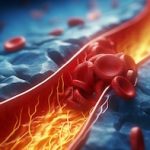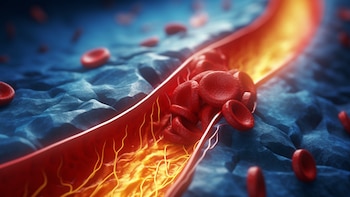



His heart It beats 100,000 times a day. He works a lot and has risk factors that increase the likelihood of developing cardiovascular disease. The main Enemies of the heart are high blood pressure, high cholesterol, a sedentary lifestyle, diabetes, obesity, smoking and stress.. The good news is that many are preventable with healthy lifestyle habits.
One in three people, on average, has high blood pressure and half of those affected do not know it. It is surprising because it is something very easy to measure, you go to a pharmacy, they take your pressure and with one or two shots, you already know if it is hypertensive and consult the doctor.
The ideal, the normal, would be to have 130 maximum or less and 85 minimum or less. When is someone hypertensive? When the maximum or minimum exceeds a certain limit. What is that limit? When the maximum is 140 or more and the minimum is 90 or more. It is easy to diagnose and easy to control.

Have high cholesterol plays against his cardiovascular health. So much heart like brain. Above all the cholesterol called bad, the LDL. Then we have another cholesterolhe HDLwhich is the good one, is the one that blocks the arteries. There are three types of important numbers to consider in a blood test:
- Total cholesterol: Ideally, it should be below 200 mg/dl. Values greater than 240 mg/dl are considered abnormal.
- HDL cholesterol (“good” cholesterol): If the level is 60 mg/dl or more, it is considered to have a protective effect. Levels between 40 and 59 mg/dl are acceptable, but the higher the HDL, the better.
- LDL cholesterol (“bad” cholesterol): The optimal thing is to keep it at 100 mg/dl or less. Although it is considered acceptable to have it between 100 and 130 mg/dl, it is most advisable to keep it below 100 mg/dl to prevent risks.

Not moving, not having Physical activity is a huge risk factor that increases the likelihood of developing cardiovascular diseases. I once told you, what doesn’t move rusts.
Although walking may seem like a simple activity, it is an effective way to keep moving without requiring special equipment. According to the World Health Organization (WHO), one in four adults does not meet physical activity recommendations. The WHO advises doing a minimum of 150 minutes of moderate exercise or 75 minutes of vigorous activity per week, something that can be achieved with a 30-minute walk five days a week.

Overweight and obesity generate a picture of chronic inflammation low grade that damages the cardiovascular system. Again the heart and the brain. The cerebral circulation. Furthermore, the obesity is related to the high blood pressurewith the diabeteswith the cholesterol. That is, the obesity It already conditions those three things.
The WHO points out that “obesity is a complex chronic disease that is defined by an excessive accumulation of fat that can be harmful to health, which can lead to an increased risk of type 2 diabetes and heart disease, can affect bone health and reproduction and increases the risk of certain types of cancer.
Diabetes is a chronic disease that affects millions of people around the world and is characterized by high levels of glucose or sugar in the blood. It’s a metabolic disorder which occurs when the body does not produce enough insulin or does not use it efficiently.
The type two diabetes is really a cardiovascular risk factor. It is easy to diagnose. One blood test, and it’s treated quite easily.

Neither I nor any doctor has an antidote for it. tobacco. If one takes care of oneself a little less with food, one can regularly control the cholesterol with medication, blood pressure. We doctors can do something to help you, but with the cigarette No.
If you smoke, the only thing you can do is quit. I tell you this way: He tobacco It has no antidote.
And finally, the stress. What we understand as suffering sustained human in time.
In my opinion, the word that best defines the stress It is “suffering.” And as I reflect on this, I remember a phrase from Siddhārtha Gautama, Buddhawhich I want to share: “Pain in life is inevitable, but suffering is optional.” It seems like an extraordinary phrase to me. He stress is a great enemy of his heart.
It’s not many things. Control them. Make diagnosis. Take care of your heart.
* Dr. Daniel López Rosetti is a doctor (MN 62540) at the Faculty of Medicine of the University of Buenos Aires (UBA). President of the Stress Section of the World Federation for Mental Health (WFMH). And he is the author of books such as: “Emotion and feelings” (Ed. Planeta, 2017), “Equilibrio. How we think, how we feel, how we decide. User Manual.” (Ed. Planeta, 2019), among others.
